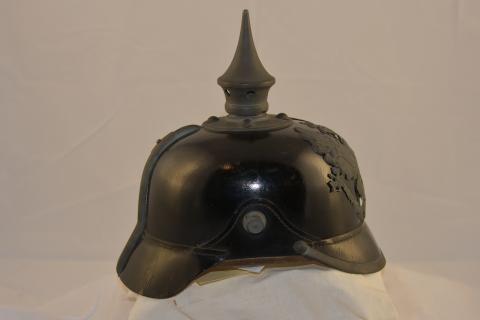This is a German Pickelhaube helmet, made of black boiled leather and gray metal accents. The most distinctive feature of the Pickelhaube is its iconic dorsal spike, which is made of metal and provides holes for the helmet to breathe. The insignia adorning the front face of the helmet is the crowned eagle of the German Empire, with an orb in one talon and a scepter in the other. Across the breast of the eagle is an inscription which reads, "MIT GOTT FUR UND VATERLAND." This translates roughly to, "With God and for the Fatherland." The neck of the eagle is inscribed with the letters, "Koenig," which translates to "King." The letters "F.R." are also inscribed on the eagle's chest. These letters, combined with "Koenig," are symbolic of Frederick I, the first king of a united Prussia. For much of the 19th century, the Pickelhaube was a staple of Prussian military uniform. When the North German Confederation was consolidated under Prussia's leadership in 1870, the German Empire was born and the Pickelhaube became the standard helmet of the German Army. After the Franco-Prussian War of 1870 (which resulted in German unification), the Pickelhaube became iconic throughout Europe and synonymous with ambitious German military expansion.
During World War I, the Pickelhaube proved too expensive to produce on an industrial scale and could not adequately protect its wearer from the realities of industrial-scale warfare. It was soon phased out and replaced by the Stahlhelm design, although it remained in ceremonial use in parts of Germany. This content can be used with the following resources: SS.4.25: Technological Change This content can be used to educate students on the evolution of military protective technology during the First World War in terms of helmet technology and how the changes introducted during this time impacted changes in the service of Iowa soldiers. For any use other than instructional resources, please check with the organization that owns this item for any copyright restrictions.

